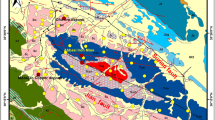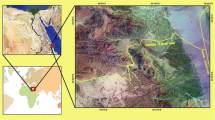Abstract
Podiform chromite ore deposits in ultramafic parts of ophiolite rock complexes can be detected using remote sensing data. This study focuses on the discrimination of chromite bearing mineralized zones using Landsat TM and Advance Spaceborne Thermal Emission and Reflection Radiometer (ASTER) satellite data in Abdasht ophiolite complex, south of Iran. Several image processing methods, including Log residual, Decorellation Stretch, Band ratio and Mixture-Tuned Matched-Filtering (MTMF) have been evaluated for lithological mapping using Landsat ETM and ASTER data. The outcome showed that TIR band ratios of ASTER can discriminate quartzite, carbonate and mafic–ultramafic rocks in the ophiolite complex. Log residual, Decorollation Stretch and MTMF methods were more capable than previous published ASTER methods specifically for lithological mapping at a regional scale. New geological map of Abdasht region was produced based on the interpretation of ASTER image processing results and field verification. Consequently, the proposed methods demonstrated the ability of ASTER and Landsat ETM data to provide information for detecting chromite host rock (serpentinized dunites) that is valuable for chromite prospecting in study area. Additionally, the techniques used in this study are subtle for exploration geologist and mine engineering to identify high-potential chromite-bearing zones in the ophiolite complex, minimizing costly and time-consuming field works.










Similar content being viewed by others
References
Abdeen M, Allison T, Abdelsalam MG (2001) Application of ASTER band-ratio images for geological mapping in arid regions; the Neoproterozoic Allaqi Suture Egypt. Abstr Prog Geol Soc Am 3(3):289
Aboelkhair H, Yoshiki N, Yasushi W, Isao S (2010) Processing and interpretation of ASTER TIR data for mapping of rare-metal-enriched albite granitoids in the Central Eastern Desert of Egypt. J Afr Earth Sci 58(1):141–151
Abrams M (2000) The Advanced Spaceborne Thermal Emission and Reflection Radiometer (Aster) data products for the high spatial resolution imager on NASA’s Terra platform. Int J Remote Sens 21:847–859
Abrams M, Hook SJ (1995) Simulated Aster data for geologic studies. IEEE Trans Geosci Remote Sens 33(3):692–699
Alavi M (1991) Tectonic of the Zagros orogenic belt of Iran: new data and interpretations. Tectonophysics 229:211–238
Amer R, Kusky T, Ghulam A (2010) Lithological mapping in the Central Eastern Desert of Egypt using ASTER data. J Afr Earth Sci 56:75–82
Azizi H, Tarverdi MA, Akbarpour A (2010) Extraction of hydrothermal alterations from ASTER SWIR data from east Zanjan, northern Iran. Adv Space Res 46:99–109
Bedini A (2011) Mineral mapping in the Kap Simpson complex, central East Greenland, using HyMap and ASTER remote sensing data. Ore Geo Rev 47:60–73
Behzadi H (1992) Study of chemichal composition of ophiolite complex in north of Baft. Ms thesis, University of Bahonar, Kerman ,Iran, pp. 75–145
Boardman JW, Kruse FA, Green RO (1998) Mapping target signatures via partial unmixing of AVIRIS data. Proceedings of the Fifth JPL Airborne Earth Science Workshop, Pasadena, CA, pp. 23–26
Gad S, Kusky T (2007) ASTER spectral ratioing for lithological mapping in the Arabian–Nubian shield, the Neoproterozoic Wadi Kid area, Sinai, Egypt. Gondwana Res 11:326–335
Gillespie AR, Matsunaga T, Rokugawa S, Hook SJ (1998) Temperature and emissivity separation from Advanced Spaceborne Thermal Emission and Reflection Radiometer (ASTER) images. IEEE Trans Geosci Remote Sens 36:1113–1126
Green AA, Berman M, Switzer P, Craig MD (1988) A transformation for ordering multispectral data in terms of image quality with implications for noise removal. IEEE Trans Geosci Remote Sens 26(1):65–74
Hashim et al (2011) Processing and interpretation of Advanced Space Borne Thermal Emission and Reflection Radiometer (ASTER) data for lithological mapping in ophiolite complex. Int J Phys Sci 6(28)
Inzana J, Kusky T, Higgs G, Tucker R (2003) Supervised classifications of Landsat TM band ratio images and Landsat TM band ratio image with radar for geological interpretations of central Madagascar. J Afr Earth Sci 37:59–72
Iwasaki A, Tonooka H (2005) Validation of a crosstalk correction algorithm for ASTER/SWIR. IEEE Trans Geosci Remote Sens 43:2747–2751
Khan SD, Mahmood K, Casey JF (2007) Mapping of Muslim Bagh ophiolite complex (Pakistan) Using new remote sensing and field data. J Asian Earth Sci 30:333–343
Kruse FA, Boardman JW (2000) Characterization and mapping of kimberlites and related diatremes using hyperspectral remote sensing. Proceedings 2000 IEEE Aerospace Conference, Big Sky, MO, March 18–24
Kruse FA, Bordman JW, Huntington JF (2003) Comparison of airborne hyperspectral data and EO-1 Hyperion for mineral mapping. IEEE Trans Geosci Remote Sens 41:1388–1400
Madani A, Emam A (2009) SWIR ASTER band ratios for lithological mapping and mineral exploration: a case study from El Hudi area, southeastern desert, Egypt. Arab J Geosci 4:45–52
Mc Call (1997) The geotectonic history of the Makran and adjacent areas of southern Iran. J Asian Earth Sci 15(6):517–531
Ninomiya Y (2003) A stabilized vegetation index and several mineralogic indices defined for ASTER VNIR and SWIR data. IEEE International Symposium on Geoscience and Remote Sensing Toulouse, France, pp. 1552–1554
Ninomiya Y (2004) Lithologic mapping with multispectral ASTER TIR and SWIR data. Proc SPIE 5234:180–190
Ninomiya Y et al (2005) Detecting lithology with Advanced Spaceborne Thermal Emission and Reflection Radiometer (ASTER) multispectral thermal infrared “radiance-at-sensor” data. Remote Sens Environ 99(1–2):127–139
Pour AB, Hashim M (2011a) Spectral transformation of ASTER and the discrimination of hydrothermal alteration minerals in a semi-arid region SE Iran. Int J Phys Sci 6(8):2037–2059
Pour BA, Hashim M (2011b) Identification of hydrothermal alteration minerals for exploring of porphyry copper deposit using ASTER data, SE Iran. J Asian Earth Sci 42:1309–1323
Pour BA, Hashim M (2012a) The application of ASTER remote sensing data to porphyry copper and epithermal gold deposits. Ore Geol Rev 44:1–9
Pour BA, Hashim M (2012b) Identifying areas of high economic-potential copper mineralization using ASTER data in Urumieh-Dokhtar Volcanic Belt, Iran. Adv Space Res 49:753–769
Pour BA, Hashim M (2013) Fusing ASTER, ALI and Hyperion data for enhanced mineral mapping. International Journal of Image and Data Fusion. doi:10.1080/19479832.2012.753115
Pour AB, Hashim M, Marghany M (2011) Using spectral mapping techniques on short wave infrared bands of ASTER remote sensing data for alteration mineral mapping in SE Iran. Int J Phys Sci 6(4):917–929
Qari MHT, Madani A, Matsah MIM, Hamini Z (2008) Utilization of ASTER and LANDSAT data in geological mapping of basement rocks of Arafat area, Saudi Arabia. Arab J Sci Eng 33:99–116
Qiu F, Abdelsalam M, Thakkar P (2006) Spectral analysis of ASTER data covering part of the Neoproterozoic Allaqi-Heiani suture, Southern Egypt. J Afr Earth Sci 44:169–180
Rajendran S, Balamurugan G, Shankar K (2011) Discrimination of iron ore deposits of granulite terrain of Southern Peninsular India using ASTER data. J Asian Earth Sci 41:99–106
Rowan LC, Mars JC (2003) Lithologic mapping in the Mountain Pass, California area using Advanced Spaceborne Thermal Emission and Reflection Radiometer (Aster) data. Remote Sens Environ 84:350–366
Rowan LC, Mars JC, Simpson CJ (2005) Lithologic mapping of the Mordor, NT, Australia ultramafic complex by using the Advanced Spaceborne Thermal Emission and Reflection Radiometer (ASTER). Remote Sens Environ 99:105–126
Rowan L, Awrence C, Robert G, Schmidt MJC (2006) Distribution of hydrothermally altered rocks in the Reko Diq, Pakistan mineralized area based on spectral analysis of ASTER data. Remote Sens Environ 104:74–87
Sabzehei M, Watters M (1970) Preliminary report on the geology and petrography of the metamorphic and igneous rocks of central part of Neiriz. Geological Survey of Iran
Stoklin J (1974) Possible ancient continental margins in Iran. In: Burk CA, Drake CL (eds) The geology of continental margins. Springer, Berlin, pp 873–887
Thome K, Palluconi F, Takashima T, Masuda K (1998) Atmospheric correction of ASTER. IEEE Trans Geosci Remote Sens 36(4):1119–1211
Acknowledgments
We are grateful to the Baft Branch, Islamic Azad University, for financing and funding this research through Research University Grant. In addition, special thanks to Universiti Teknologi Malaysia (UTM) for supporting and providing equipment and information sources that assisted this study.
Author information
Authors and Affiliations
Corresponding author
Rights and permissions
About this article
Cite this article
Pournamdari, M., Hashim, M. Detection of chromite bearing mineralized zones in Abdasht ophiolite complex using ASTER and ETM+ remote sensing data. Arab J Geosci 7, 1973–1983 (2014). https://doi.org/10.1007/s12517-013-0927-0
Received:
Accepted:
Published:
Issue Date:
DOI: https://doi.org/10.1007/s12517-013-0927-0




